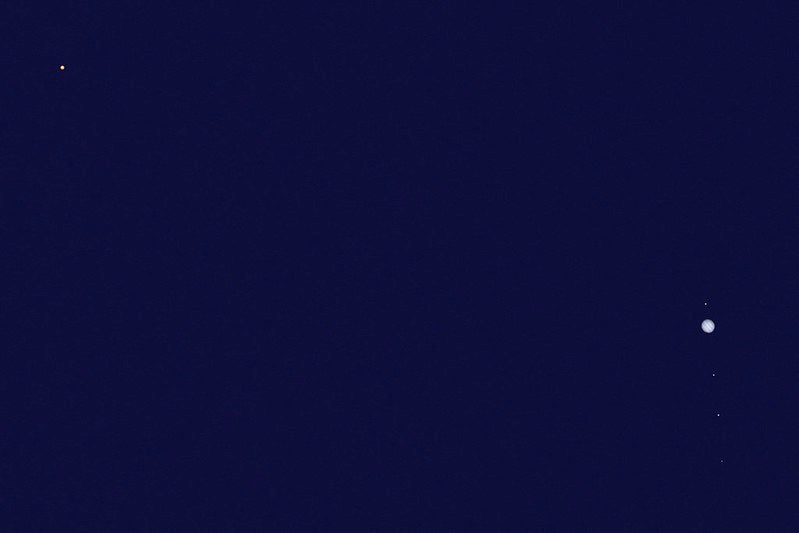
Friday, August 9
Still about 50° high in the west some two hours after the Sun has set, our target for tonight is NGC 5962, a so-called “flocculent” spiral in the constellation Serpens Caput. It’s located about 2.6° northwest of magnitude 3.7 Beta (β) Serpentis, one of the three stars in a triangular formation that make up the Serpent’s head.
NGC 5962 shines at magnitude 11.3 and is oval-shaped, roughly 3′ by 2′ on the sky. You’ll want a larger scope to see it best. It’s called a flocculent spiral because its winding arms appear patchy, rather than glowing uniformly. See how much detail you can make out — make use of averted vision, by looking slightly away from the object toward the edge of your eyepiece. You might see the faint arms better out of the corner of your eye.
Sunrise: 6:06 A.M.
Sunset: 8:04 P.M.
Moonrise: 11:02 A.M.
Moonset: 10:26 P.M.
Moon Phase: Waxing crescent (23%)
*Times for sunrise, sunset, moonrise, and moonset are given in local time from 40° N 90° W. The Moon’s illumination is given at 12 P.M. local time from the same location.
Saturday, August 10
The Moon passes 0.7° north of Spica at 6 A.M. EDT. By nightfall, the two are a little over 10 times that distance, standing 7° apart in the west as they slowly set. The Moon is now some 35 percent lit, showing off a gorgeous crescent along its eastern limb. However, the western portion of the nearside may be visible through a phenomenon called earthshine, when sunlight bounces off Earth and illuminates the part of the Moon still in shadow. Viewing the Moon through a telescope under these conditions is often particularly rewarding.
Spica, which shines at magnitude 1, is now to the Moon’s lower right. This star lies so close to the ecliptic that it is often occulted by the Moon — and observers in eastern Asia and Indonesia may be able to catch such an event. The International Occultation Timing Association has more details on their website for the event, including timing and locations where the occultation is visible. Both set about two and a half hours after the Sun.
Spica is a blue-white star that is actually a binary, though the components are 10 times closer than Earth is to the Sun. The tight pair circle each other every 4 days. Both are B-class stars several times the Sun’s mass and size; at least one of the two is massive enough to likely explode as a brilliant supernova at the end of its life, though the other will more slowly transform into a white dwarf, as the Sun will do when it reaches the end of its hydrogen supply.
Sunrise: 6:07 A.M.
Sunset: 8:02 P.M.
Moonrise: 12:02 P.M.
Moonset: 10:47 P.M.
Moon Phase: Waxing crescent (32%)
Sunday, August 11
Mercury passes 6° south of Regulus, Leo the Lion’s alpha star, at 6 P.M. EDT. The tiny planet is heading quickly for its August 18 inferior conjunction with the Sun and is now so low in the evening sky that it may be impossible to catch. It’s a mere 1° high at sunset and glowing a faint magnitude 2.2. If you do try to spot it, take care not to use any optics until the Sun is completely below the horizon from your observing site, which is heavily location-dependent and may differ from the time listed below.
Although Mercury is a miss, bright Venus will be easy to catch, still nearly 10° high at sunset and magnitude –3.9. Through a telescope, the planet’s disk stretches a good 10″, showing off its nearly full illumination (95%). It sets within about an hour of the Sun, so although it’s easier to find, you’ll still need to be relatively quick.
Venus, too, is getting harder to catch, though not as quickly as Mercury. Come back every night to watch its height above the horizon, and you’ll notice Venus is moving nearly horizontally, rather than upward, so that it is lower after sunset and sets earlier each day.
Sunrise: 6:08 A.M.
Sunset: 8:01 P.M.
Moonrise: 1:04 P.M.
Moonset: 11:12 P.M.
Moon Phase: Waxing crescent (41%)
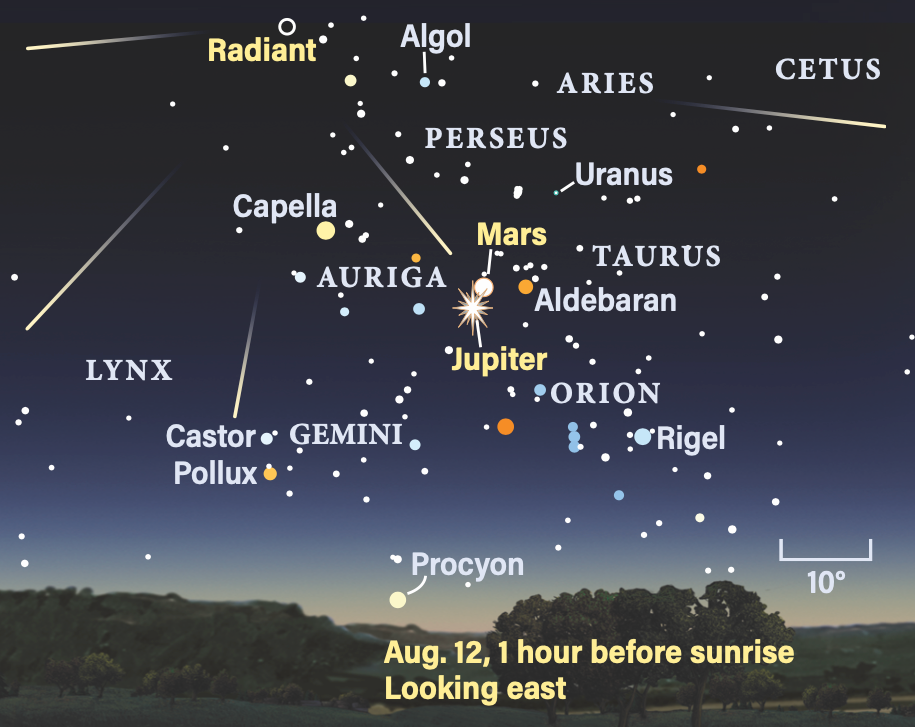
Monday, August 12
The Perseid meteor shower is one of the top meteor showers of the year — and, in fact, this year will outshine even the more famous Geminids in December, as the latter occurs near a Full Moon.
The Perseids peak today, just as the Moon is approaching First Quarter phase, which occurs at 11:19 A.M. EDT. The best time to watch for shower meteors will be early this morning in the few hours before dawn, when the radiant — the point from which shower meteors appear to originate — in the constellation Perseus is highest.
Look east about two hours before sunrise, and you’ll be greeted by quite a sight. Just rising above the horizon are Gemini and Orion, the latter’s famous belt appearing to stand straight up as three stars stacked on top of each other. Above Orion is Taurus, with its bright red eye, Aldebaran. Look just left of Aldebaran, though, and you’ll see two bright points of light very close together — these are Mars and Jupiter, now standing roughly 1° apart. It’s a preview of their close conjunction, which occurs in two days’ time, so make sure to set your alarm again on the 14th and read ahead to that entry in this column to know what to expect.
But the two planets are not our main focus this morning — that’s higher in the sky, as above Taurus sits the constellation Perseus. The Perseids’ radiant is in northern Perseus, about 23° straight above the bright star Capella in the constellation Auriga, which lies to Perseus’ lower left.
The expected maximum zenithal hourly rate for the Perseids this year is about 100 meteors per hour. With the radiant reaching some 60° above the horizon an hour before sunrise, you can expect to see some 80 to 85 meteors per hour — more than a meteor per minute! Note, however, that this is a time-averaged value, so you may see numerous meteors in a short time, then go several minutes without any visible. Nonetheless, with no Moon in the morning sky and the warm temperatures of late summer, the Perseids are likely to dazzle.
Sunrise: 6:09 A.M.
Sunset: 8:00 P.M.
Moonrise: 2:08 P.M.
Moonset: 11:42 P.M.
Moon Phase: Waxing gibbous (51%)
Tuesday, August 13
The Moon stands in Scorpius this evening, visible in the south after sunset. Our satellite lies just below magnitude 2.9 Sigma (σ) Scorpii, and to the lower right of 1st-magnitude Antares, the Scorpion’s alpha star. Luna will pass 0.004° (that’s roughly 14″) south of Antares overnight this evening, standing due south of the star at 1 A.M. EDT on the 14th (still late on the 13th for the western half of the U.S.).
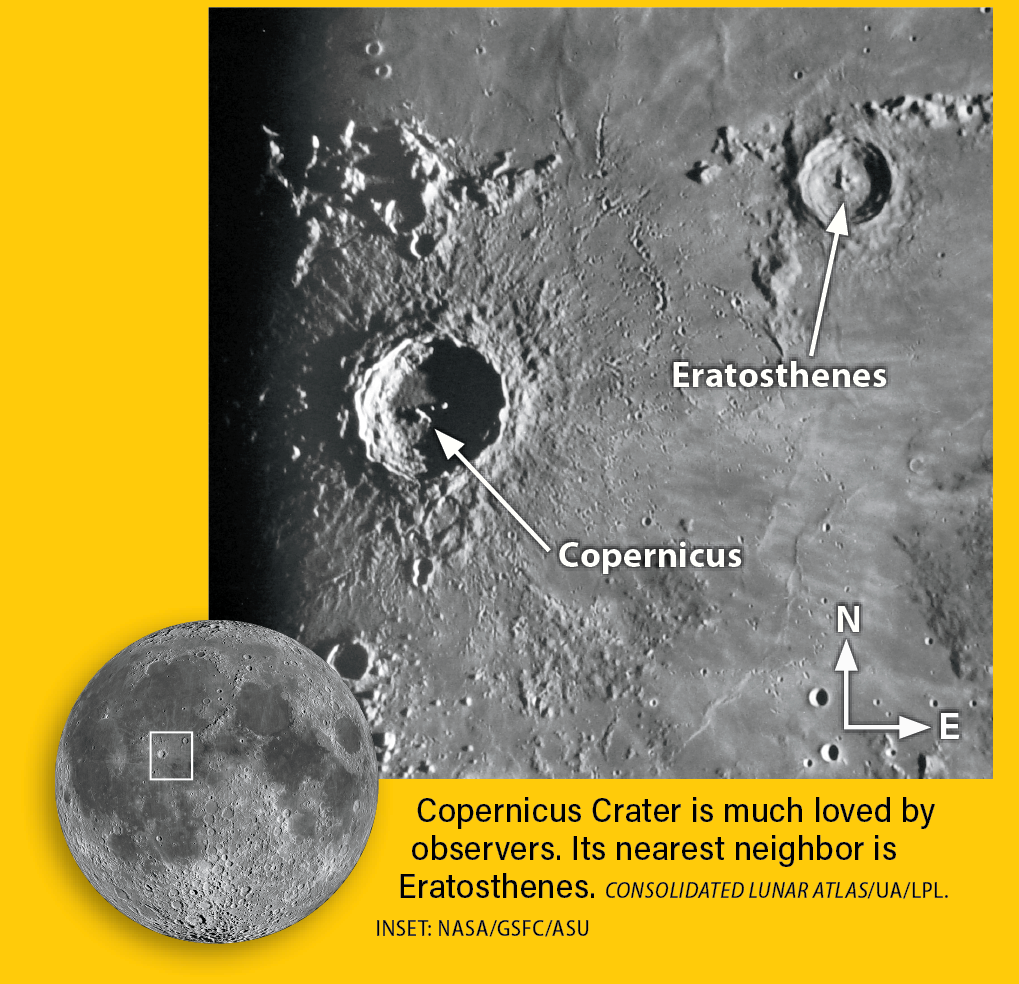
For observers in southern South America (or anyone who happens to be reading this from portions of Antarctica), the Moon will also occult, or pass in front of, Sigma Sco late tonight — visit the International Occultation Timing Association’s website for the event to see whether (and when) it is visible from your location.
Swing a telescope up to Earth’s natural satellite this evening to look along the terminator, the dividing line between night and day on the lunar surface. Just visible as sunlight hits its western rim is the large round crater Copernicus, with smaller Eratosthenes, similarly lit, to its northeast. The angle of the sunlight falling over these two pockmarks accentuates the rough terrain around them — particularly Copernicus, which is surrounded by an apron of textured terrain, called ejecta, that was thrown out during the impact that created it. Peer closely at the crater’s walls at high power, and you’ll notice they appear stepped like a staircase leading down to the still-darkened floor of the 58-mile-wide (93 kilometers) crater.
Smaller Eratosthenes is roughly 37 miles (60 km) wide, though its better-illuminated central peak provides a great target for study as well. It, too, has an inner rim like a staircase, but little ejecta of its own. Instead, see whether you can follow the rays of material from Copernicus, which must have come later, lying over the landscape here.
Sunrise: 6:10 A.M.
Sunset: 7:59 P.M.
Moonrise: 3:14 P.M.
Moonset: —
Moon Phase: Waxing gibbous (61%)
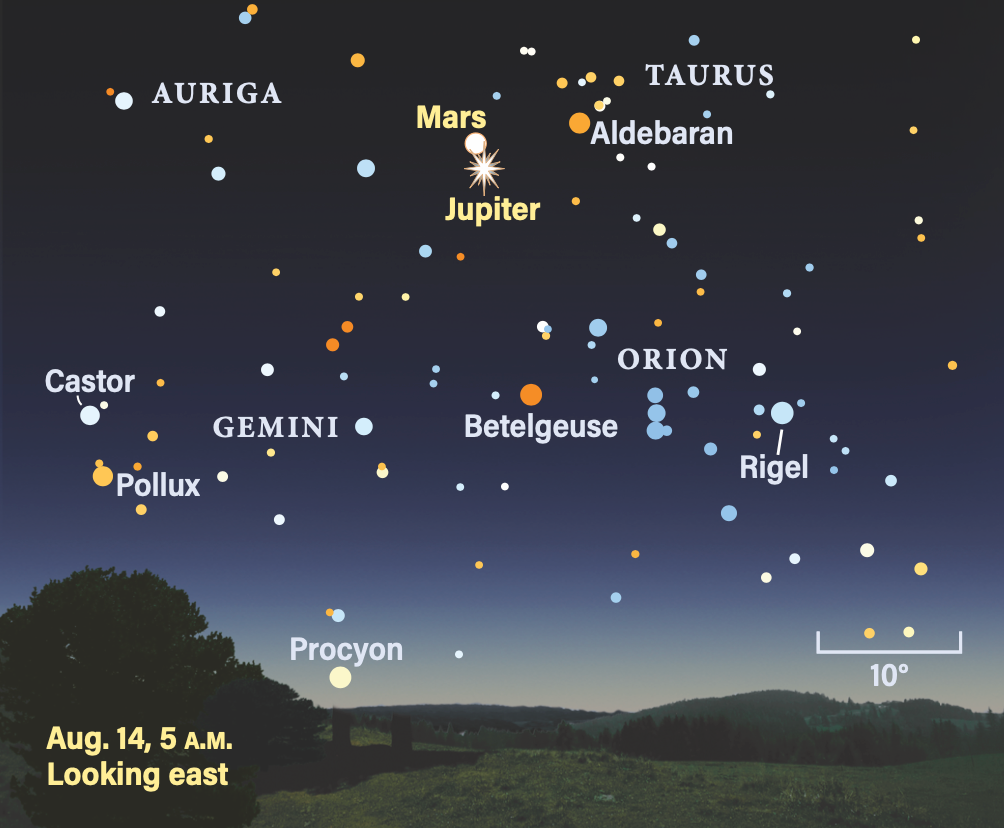
Wednesday, August 14
The Moon passes 0.004° south of Antares at 1 A.M. EDT. But the real show is a bit later this morning in the few hours leading up to sunrise, when Mars and Jupiter stand just 0.3° apart — a conjunction close enough to capture both in the field of view of binoculars or a telescope.
The pair lies in Taurus, between the horns of the Bull and just over 8° to the left (northeast) of Aldebaran this morning. Jupiter blazes at magnitude –2.2; Mars, at magnitude 0.8, is some 16 times fainter. Early this morning, the Red Planet lies just northwest of Jupiter — Mars will pass 0.3° due north of the gas giant at 1 P.M. EDT.
This is a pairing you won’t want to miss, best seen in the hour or two before sunrise, when the region rises above 30° in altitude in the east. Through your eyepiece, both planets should show off clear disks, though Mars’ spans just 6″, offering little detail. But Jupiter is a different story — stretching 37″ across, the king of planets offers a wealth of detail, including visible cloud bands.
Depending on the time (i.e., your location), you may catch the Great Red Spot rotating off the disk, disappearing over the western limb. Also depending on the time, you may spot Io’s shadow moving across the planet’s cloud tops in a transit that starts around 4:40 A.M. EDT and lasts just over two hours. Note that Io is approaching from the east, followed by Europa — whose own shadow chases Io’s onto the disk just after 5:30 A.M. EDT, not long before sunrise on the East Coast. Io itself begins a transit around 4:55 A.M. CDT, with Europa finally sliding in front of the disk around 5 A.M. PDT, just minutes before Io finishes its transit and moves away to the west. Note these last events are only visible on the West Coast. And the later you observe, the closer to due north of Jupiter Mars will stand — see if you can catch the subtle motion over the course of a few hours if you’re up early to enjoy the view.
Sunrise: 6:11 A.M.
Sunset: 7:57 P.M.
Moonrise: 4:20 P.M.
Moonset: 12:18 A.M.
Moon Phase: Waxing gibbous (70%)
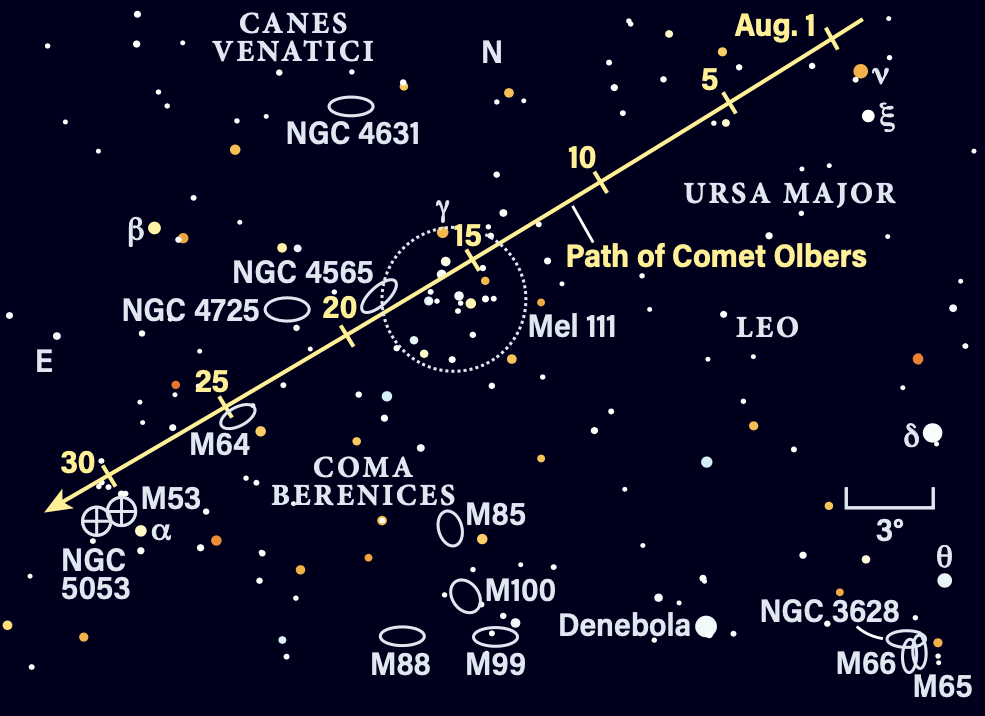
Thursday, August 15
Comet 13P/Olbers is passing through the gorgeous Coma Star Cluster tonight, a slightly challenging pairing for visual observing with the Moon’s bright presence but a not-to-be-missed target for astrophotography.
Start looking as soon as the sky begins to grow dark after sunset. The cluster, cataloged as Melotte 111, spans 4° and is visible to the naked eye from a dark site (though again, the Moon may interfere today). Try looking for it in the hour or two after sunset, near 4th-magnitude Gamma (γ) Comae Berenices as that small constellation slowly sinks in the west. Olbers is 1.5° southwest of Gamma tonight, just entering the cluster at its northwestern edge. The comet will spend another day or two amid the cluster’s several dozen brightest stars, moving southeast each day.
Olbers is roughly 7th magnitude, now fading after reaching 6th magnitude at the beginning of July. The comet returns to the Sun every 68 years and will only be observable in the Northern Hemisphere through November, though it is now fading as well and will only get harder to see, regardless of whether it remains above the horizon. However, it’s still putting on a show this month, and we’ll return when the Moon retreats from the sky in several days and Olbers passes by a famous galaxy, M64.
Sunrise: 6:12 A.M.
Sunset: 7:56 P.M.
Moonrise: 5:22 P.M.
Moonset: 1:06 A.M.
Moon Phase: Waxing gibbous (79%)
Friday, August 16
While Mars and Jupiter continue to draw attention, now nearly a degree apart in Taurus, let’s look to the Bull’s southwest (upper right) in the early-morning hours to enjoy Cetus the Whale, a large constellation covering some 1,230 square degrees of sky.
The constellation’s second-brightest star is Menkar, which lies close to Cetus’ border with Taurus. Nonetheless, magnitude 2.5 Menkar is cataloged as Alpha (α) Ceti. Nearly 13° to the right (southwest) of Menkar is magnitude 6.5 Mira (Omicron [ο] Ceti). This seemingly unobtrusive star is a variable whose brightness waxes and wanes over the course of nearly a year. Mira can get as bright as magnitude 2 or as faint as magnitude 9. It recently reached its peak magnitude around April and is slowly dipping back down to its minimum late this year.
In fact, Mira is now middling-6th-magnitude, meaning unless your eyes are sharp and the sky steady and dark, you might not spot it without the aid of binoculars or a telescope. According to the late Jim Kaler’s STARS database, Mira is the only star with a proper name that is not always visible to the naked eye. Can you still spot its faint glow, or is there merely a dark patch in Cetus where the star should be, unless you boost your view with a bit of magnification?
Sunrise: 6:13 A.M.
Sunset: 7:55 P.M.
Moonrise: 6:16 P.M.
Moonset: 2:04 A.M.
Moon Phase: Waxing gibbous (88%)

Sky This Week is brought to you in part by Celestron.

